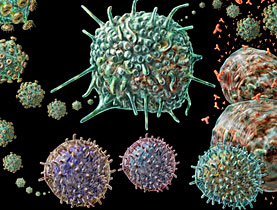
Genomics and biology join forces to fight HIV

Understanding more about why patients differ in how well they control the HIV virus has become a priority in the effort to develop new HIV/Aids treatments.
Combining the fields of genetics and biology, researchers from Lausanne and Geneva have pioneered a technique identifying the gene variants that offer resistance against the virus and are passed from generation to generation.
The results, published in PloS Biology, follow the discovery last year of three genes in the DNA of HIV-infected patients that offer protection against the virus.
The novel new method involved taking cell samples from 15 large multi-generation Mormon families in the United States, which had consented to give them to science, and injecting individual family members’ cells with the HIV virus in the laboratory.
“If there are family influences, the cells from grandchildren look like those of the grandparents and we can see how disease susceptibility is passed from generation to generation,” Amalio Telenti of Lausanne University’s institute of microbiology told swissinfo.
The laboratory observations were then compared with HIV-infected patients involved in the Swiss HIV Cohort Study, which confirmed the influence of the gene variant on the time it takes for the virus to progress.
The study allowed the scientists to identify the location where the virus interacts with an individual’s immune defence system. It also enabled them to map the susceptibility of one part of the human genome and uncover a family of proteins that had not previously been associated with HIV.
“The three genes discovered earlier are just a fraction of what is going on; 80 per cent is still unexplained,” said Telenti.
“We were looking for ways to find more genes to explain more and to have a complete cartography of all genetic influences. We are doing many other studies in consortia, but can we do it in different ways in the laboratory.”
Doldrums
Despite this advance, he says research into HIV/Aids is currently going through a “pessimistic phase” and is refocusing its efforts.
The goal of creating a vaccine to protect people against infection seems as elusive now as ever. This plunge in scientific morale follows the collapse, last year, of a massive experimental vaccine project that was regarded as one of the most promising.
In February Nobel Prize-winning biologist David Baltimore said scientists were no further forward in developing a vaccine against HIV after more than 20 years of research.
“There is a huge pressure on the vaccine people to deliver. It’s not the first time there has been a depression,” said Telenti. “But if we are going back to zero it will take another ten years of research before a vaccine can be delivered.”
Because of the recent HIV vaccine failures, lots of money has gone into genomics to see how humans defend themselves naturally and if there are any hidden clues.
“Elite controllers”
Some people do not become infected by HIV despite repeated exposure, and among those that do, there is marked variation in the clinical course and progression to full-blown Aids.
The Bill and Melinda Gates Foundation recently invested $20.5 million (SFr21.7 million) to study the genomes and immune systems of people whose bodies naturally control HIV without drugs – known as “elite controllers”.
“Maybe that’s the model,” said Telenti. “How to make infected people put the virus aside and have a completely normal existence. This is the similar to what happens with monkeys, which either don’t have much virus, or it is there but doesn’t result in diseases.”
It’s not just about vaccines, but how nature deals with it in its alternative forms and models, said the Lausanne professor.
Telenti and his team plan to continue their search for more genes that offer resistance against the HIV virus and intend to concentrate on monkey-human differences.
“Genome research is huge at the moment. We celebrated the fact that the human genome was available in 2001, but we also got the chimpanzee, orang-utan, macaque and marmoset genomes. We are now in a position for the first time to make wide comparisons with our distant relatives.”
“Over the next ten years we are going to learn a lot about human evolution, migration and genetics of most common diseases which will lead to specialised medicine.
“Nobody knows how this information will impact on human behaviour, but it will certainly allow us to better understand the disease, develop drugs or maybe one day develop a vaccine.”
swissinfo, Simon Bradley in Lausanne
The human immunodeficiency virus (HIV) is a retrovirus that infects cells of the human immune system, destroying or impairing their function.
As the infection progresses, the immune system becomes weaker, and the person becomes more susceptible to so-called opportunistic infections.
The most advanced stage of HIV infection is acquired immunodeficiency syndrome (Aids). It can take 10-15 years for an HIV-infected person to develop Aids; antiretroviral drugs can slow down the process even further.
According to the UN, an estimated 39.5 million people are living with HIV. In 2006 2.9 million people died of Aids-related illnesses.

In compliance with the JTI standards
More: SWI swissinfo.ch certified by the Journalism Trust Initiative





























You can find an overview of ongoing debates with our journalists here . Please join us!
If you want to start a conversation about a topic raised in this article or want to report factual errors, email us at english@swissinfo.ch.